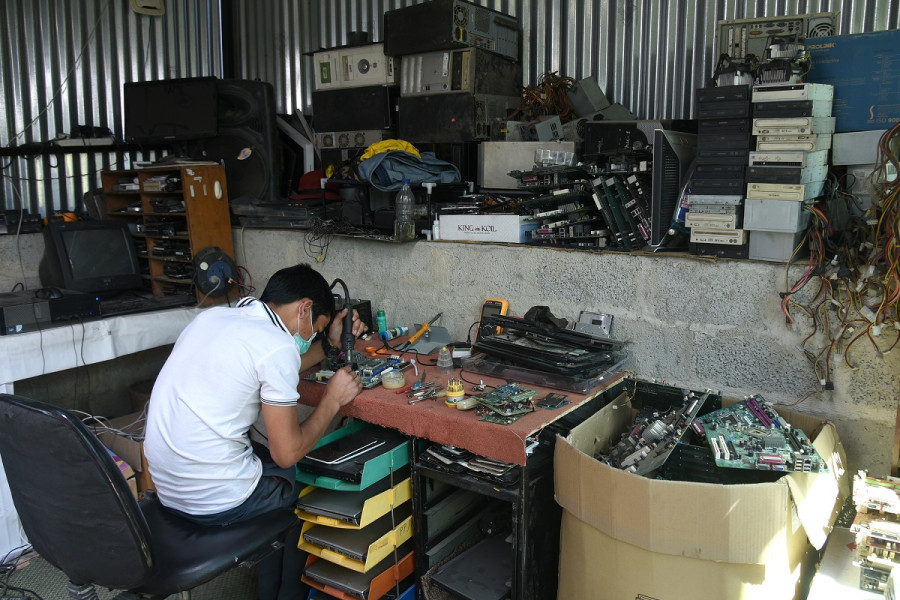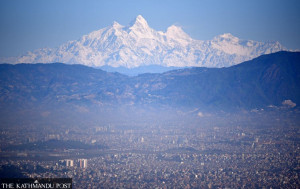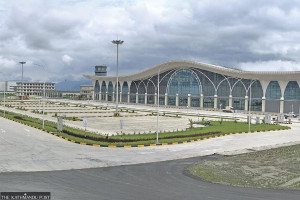Climate & Environment
Use of electronic goods continues to grow but there’s no policy for its disposal
Most of the e-waste generated in the country comes from television sets, computer display monitors, and refrigerators. More people are also disposing of their phones.
Chandan Kumar Mandal
In the absence of dedicated policies to regulate and properly manage them, electronic waste (e-waste) has emerged as yet another menace for the country where more and more people are buying electronic gadgets such as smartphones.
Environmentalists, government officials, and experts on waste management have expressed concerns as people are using more and more electronic gadgets to meet their daily needs. Such items, once discarded, turn into e-waste.
“From our morning alarm to the moment we go to bed, we are surrounded by electronic gadgets either at home or outdoors,” said Jyoti Giri, assistant professor at Tri-Chandra Multiple College, during a virtual interaction organised by Tech Journos’ Forum.
“During the Covid-19 pandemic, we added more electronic gadgets such as ventilators, inhalers, thermometers, and more mobile phone sets and laptops as educational institutions and offices remained shut. In the next few years, these newly bought laptops and mobile phones will all end up as e-waste.”
Step Initiative, an international organisation seeking solutions to e-waste issues, says e-waste refers to all electrical and electronic equipment and their parts that have been discarded by owners as waste without the intent of re-use.
It lists six e-waste categories: temperature exchange equipment, screens, lamps, large equipment, small equipment, and small information technology and telecommunication equipment.
According to the Global E-waste Monitor 2020, which said a record 53.6 million tonnes of e-waste was generated globally in 2019, Nepal produced 28 metric kilotons of e-waste in the same year. The same report said that as global e-waste volumes have increased by 21 percent in the past five years, an average Nepali generated 900gm of e-waste in 2019.
Despite the massive generation of e-waste and its hazardous impact on public health and the environment, e-waste management has not blipped on the government’s radar.
“There is a lack of legislation for addressing e-waste-related problems and bringing the private sector in the e-waste recycling business. We also don’t have adequate technology for its proper management,” said Giri, who also researches on electronic and plastic waste. “E-waste collection and its disposal is happening in the informal sector. Although Nepal is a signatory to the Basel Convention, which bars transboundary movement of hazardous waste and its disposal, e-waste is being sent to India through illegal channels.”
The unsafe handling of used electronic devices and e-waste can lead to serious harm to human health and the environment. Open-air burning and disposal of e-waste, which also contains toxic materials, can pollute soil, water and air.
Such practices can expose workers to high levels of contaminants such as lead, mercury, cadmium, and arsenic, leading to irreversible health effects, including cancers, miscarriages, neurological damage, and diminished IQs, according to the Environmental Protection Agency of the US.
“Despite its hazardous health and environmental impacts, e-waste is being handled carelessly and collected like ordinary solid garbage. Families dispose of e-waste in their household garbage. It ultimately reaches landfill sites, or is sold to scrap hawkers,” said Giri. “What we need to do is follow the sustainable and smart practice of 3R—reduce, reuse, and recycle. First, buy fewer electronic gadgets, repair them if broken, and recycle them if nothing can be done. Also, we can send them for re-design, making something new from the waste.”
Giri pointed out that the Solid Waste Management Act, 2011 has provisions related to industrial and hazardous waste, but the law doesn’t talk about e-waste, making it difficult for its overall management.
Indu Bikram Joshi, deputy director of the Department of Environment, the regulatory body overseeing waste management and environmental pollution, admitted that not much has been done for dealing with e-waste issues.
“We have not done enough in the e-waste management sector. Through a study conducted in 2017, we realised the attention e-waste deserves,” said Joshi. “However, we have been mostly focused on industrial and air pollution, which could also be because of resources constraints.”
According to Joshi, also the spokesperson for the Department of Environment, the government body has been studying other countries’ practices for dealing with chemical and hazardous e-wastes to learn what could be done to manage our e-waste effectively.
Participants of the discussion also highlighted the need for creating a waste-based economy for utilising e-waste before its haphazard dumping.
“Before dumping e-waste, dismantling can be done, and valuable materials like gold, silver, copper and platinum extracted. This waste can be a resource,” said Giri. “In Nepal, some companies like Doko Recyclers are already doing this.”
According to the Global E-waste Monitor 2020, released by International Telecommunication Union and International Solid Waste Association, raw materials in the global e-waste generated in 2019 were worth approximately $57 billion. Iron, copper, and gold contribute mostly to this value.
Joshi, the government official, also pointed out that the country has been selling valuable resources at low prices.
“Waste-based businesses are part of a multi-billion dollar economy. Some resources have been tapped, but most of it has been going outside, mostly to India. We are sending valuable materials,” said Joshi. “We are gearing up to organise a waste-based economy conference soon. Like tourism-based, agro-based, and mining-based economy, we can also have a waste-based economy. It can support not only our economy but also the development of technology.”
Most of the e-waste generated in the country comes from television sets, computer display monitors, and refrigerators. According to a study by the Department of Environment on e-waste generation in 2016, cathode ray tube (CRT) desktop monitors (31 percent) and television sets (30 percent), refrigerators (16 percent) and washing machines (10 percent) were among the items discarded as waste. However, experts argue that mobile phones, liquid-crystal display (LCD) televisions, and laptop computers will constitute large volumes of e-waste in the future.
“Mobile users and internet users have grown exponentially in the last decade. In the first four months of the fiscal year, 520,000 handsets have entered Nepal every month,” said Min Kumar Aryal, director of the Nepal Telecom Authority. “Even the government policies promote the use of information and communication technology, which is significant for development, but e-waste will be its byproduct.”
Former science and technology minister Ganesh Shah said there has to be an extensive discussion on policies and laws required for regulating e-waste in the country.
“Since there is no comprehensive policy, there should be consultation among stakeholders for drafting the policy,” said Shah. “There should be a provision to enforce polluters pay policy to make producers liable for the pollution their products cause.”




 11.74°C Kathmandu
11.74°C Kathmandu











